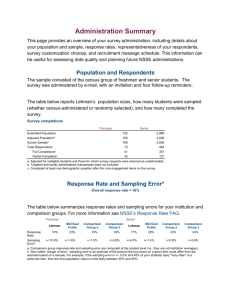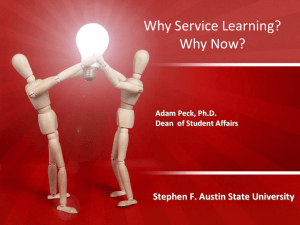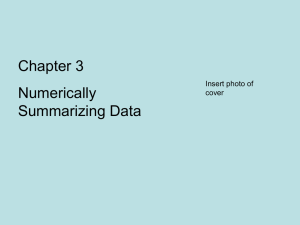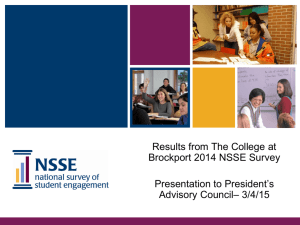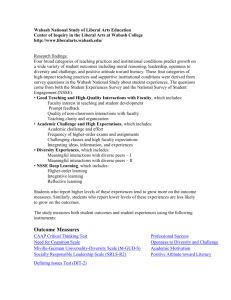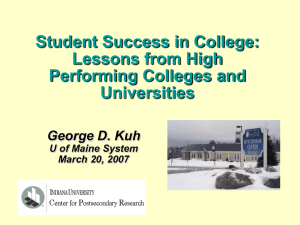Table 1. Inventory of Programs for Student Success
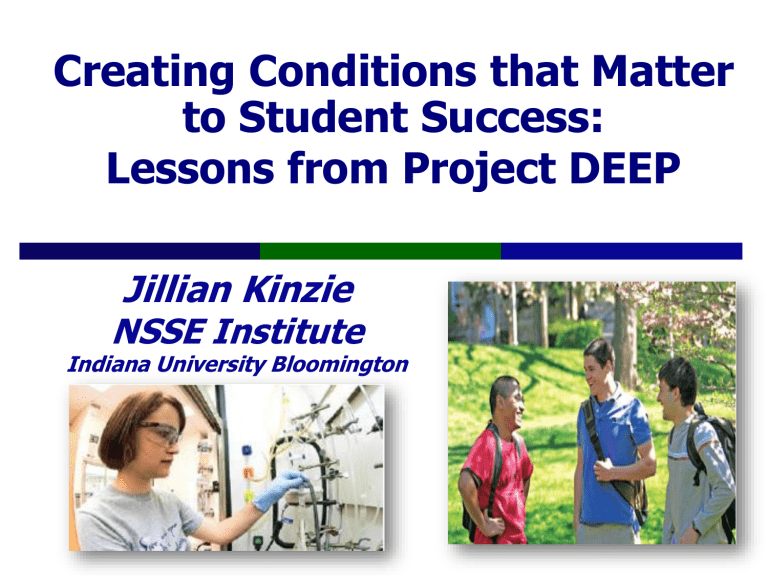
Creating Conditions that Matter to Student Success:
Lessons from Project DEEP
Jillian Kinzie
NSSE Institute
Indiana University Bloomington
Overview
Context for Conversation
Current Concerns
Research about What Matters to
Student Success
Student Engagement
Project DEEP
Sustaining the Conditions
Concerns about Quality in Higher
Education
“Colleges and universities, for all the benefits they bring, accomplish far less for their students than they should.”
“The moment has surely come for
America’s colleges to take a more candid look at their weaknesses and think more boldly about setting higher educational standards for themselves.”
Bok, D. (2006). Our Underachieving Colleges: A Candid Look at How
Much Students Learn and Why They Should Be Learning More.
Defining Student Success in College
Academic achievement; engagement in educationally purposeful activities; behaviors ; satisfaction; acquisition of desired knowledge, skills and competencies; persistence; attainment of educational objectives; and postcollege performance
Simple Facts About the Undergraduate
Experience from NSSE
1.
2.
3.
4.
Full-time students spend an average of 13 hrs per week studying (Hrs. recommended by faculty = 20-25)
45% of all college seniors took at least one course at another institution prior to enrolling at their current school –
“swirling”
45% first-years and 30% seniors never discussed ideas with faculty outside class
Faculty spend 42% of class time lecturing
(FSSE)
The Value of Student Engagement
Grades, persistence, student satisfaction, and engagement go hand in hand.
Student engagement is positively related to first-year and senior student grades and to persistence between the first & second year of college.
At institutions where faculty members use effective educational practices more frequently in their classes, students are more engaged over all and gain more from college.
How can we encourage students to take greater advantage of resources for learning???
Some Conclusions….
The times require reflective, student-centered educators, expert in their respective disciplines but also knowledgeable and skilled in areas required by these challenges
Educators must be familiar with policies and practices linked to student success
Inquiring Minds Want to Know…
What accounts for these results??
•
•
•
86% first-years and 80% of seniors “often” or “very often” worked with peers on projects during class [Alverno College]
38% first-years worked with faculty on a research project outside of class [Michigan]
85% seniors participated in community service experiences
[CSUMB]
Inquiring Minds Want to Know…
What accounts for these results??
• Transfer students are as engaged as students that started at the university
[George Mason]
• 43% first-years prepared 2 or more drafts of a paper before turning it in [Fayetteville State]
• 52% first-years and 71% seniors, “sometimes”, “often,” or “very often” tutored or taught other students [UTEP]
Promise of
Student Engagement
“If faculty and administrators use principles of good practice to arrange the curriculum and other aspects of the college experience, students would… write more papers, read more books, meet with faculty and peers, and use information technology appropriately, all of which would result in greater gains in such areas as critical thinking, problem solving, effective communication, and responsible citizenship.”
Kuh, Kinzie, Schuh, Whitt & Associates,
Student Success in College , 2005
What does an educationally effective college look like at the turn of the 21
st
century?
Project DEEP
To discover, document, and describe what strong performing institutions do to achieve their notable level of effectiveness.
Project DEEP Schools*
Doctoral Extensives
University of Kansas
*Higher-than predicted NSSE scores and graduation rates
Liberal Arts
California State, Monterey Bay
Macalester College
University of Michigan
Sweet Briar College
Doctoral Intensives
George Mason University
Miami University (Ohio)
University of Texas El Paso
The Evergreen State College
Sewanee: University of the South
Ursinus College
Wabash College
Wheaton College (MA)
Wofford College
Master’s Granting
Fayetteville State University
Gonzaga University
Longwood University
Baccalaureate General
Alverno College
University of Maine at Farmington
Winston-Salem State University
NSSE’s Five Indicators of
Effective Educational Practice
Supportive
Campus
Environment
Active &
Collaborative
Learning
What accounts for DEEP schools high NSSE benchmark scores?
Academic Challenge
Learning-intensive practices
George Mason requires every student to take from 1-3 writing-intensive courses. They along with most DEEP schools have strong writing centers to emphasize and support the importance of good writing.
Active and Collaborative
Learning
Ample applied learning opportunities
University of Maine at Farmington’s Student Work
Initiative employs students in meaningful work in student services, laboratories, and field-research.
Such experiences provide opportunities to apply what they are learning to practical, real-life situations.
Student-Faculty Interaction
Early exposure to faculty
Winston Salem State, discipline-specific orientation activities immediately immerse students in the culture of facilitate early bonds with faculty. These faculty members eventually become one of the most influential adults in students’ academic lives, making sure they are successful in all aspects of college life.
Student-Faculty Interaction
Insuring opportunities for studentfaculty contact
Fayetteville State creates opportunities for faculty members to “touch” students in a meaningful way:
•
Minority Biomedical Research Support (MBRS)
•
•
•
•
Research Initiative for Scientific Enhancement project
(RISE)
Louis Stokes Alliance for Minority Participation (LSAMP)
Departmental student organizations
Freshman Instructors provide academic, career and personal counseling
Student-Faculty Interaction
Student role in campus governance
All University of Kansas committees are required to have 20% student representation, including search and screen committees. Therefore, new faculty recruits interact with students from the start.
Enriching Educational
Experiences
Cross-cultural experiences
Alverno and George Mason intentionally craft shorter study abroad experiences that meet the needs of their large non-traditional population.
Similarly, Kansas and UMF arrange class-based trips that are more accessible to their first generation students
Enriching Educational
Experiences
Required Enriching Experiences
All Ursinus students complete an Independent
Learning Experience (ILE), such as an independent research or creative project, internship, study abroad, student teaching, or summer fellow program or comparable summer research program.
Supportive Campus
Environment
Multiple interventions woven together
At CSUMB:
Library Staff assists Capstone students to further develop their research questions and archive of Capstone projects
Senior research projects celebrated at
Capstone Conferences (Dec., May)
Describe under-served students as “vision students,” underscoring their importance at the institution
Taking Stock of
What Matters to
Student Success
- The Inventory for
Student
Engagement and
Success (ISES) -
Diagnostic
Queries
1.
2.
3.
4.
5.
6.
DEEP Results:
Conditions That Promote Student Success
“ Living ” Mission and “ Lived ”
Educational Philosophy
Unshakeable Focus on Student
Learning
Environments Adapted for Educational
Enrichment
Clearly Marked Pathways to Student
Success
Improvement-Oriented Ethos
Shared Responsibility for Educational
Quality
Lessons from Project DEEP
1.
“ Living ” Mission and “ Lived ”
Educational Philosophy
Missions, values, and aspirations are transparent and understandable.
Sustained widespread understanding and endorsement of educational purposes.
Complementary policies and practices tailored to the school ’ s mission and students ’ needs and abilities.
“Living” Mission
Macalester College students, faculty and staff understand and articulate the College’s core values of academic excellence, service, multiculturalism and internationalism. These values are enacted in the curriculum and cocurriculum.
“ Living ” Mission
“ Sea change ” at KU to emphasize undergraduate instruction
Experienced instructors teach lower division and introductory courses
Faculty members from each academic unit serve as “ Faculty Ambassadors ” to the
Center for Teaching Excellence
Course enrollments kept low in many undergraduate courses; 80% have 30 or fewer students; 93% 50 or fewer students.
2.
Lessons from Project DEEP
Unshakeable Focus on Student
Learning
Student learning and personal development are high priorities.
Extensive use of engaging pedagogies
Faculty and administrators challenge students with high standards: “ Work with the students we have, ” in contrast to focusing only on the best and the brightest
Make time for students
Ample applied learning opportunities
CSUMB requires all students to complete a lower and upper-level service learning experience. The capstone experience requires students to connect their project to community needs and reflect on “how will you act on what you know?”
Learning opportunities consistent with student characteristics
Fayetteville State University’s philosophy of
“talent development” is long-standing and pervasive: “We will meet you where you are, but we will tell you where we want you to go.”
University College: Comprehensive network of advising, support services, tutoring, early warning systems.
“Everyone has a role . . . Secretaries see themselves as extensions of advising.”
Lessons from Project DEEP
3.
Environments Adapted for Educational
Enrichment
DEEP schools make wherever they are “ a good place for a college!
”
Connected to the local community in mutually beneficial, educationally purposeful ways.
Buildings, classrooms, and other physical structures are adapted to “ human scale.
”
Psychological size fosters engagement with peers, faculty and staff.
Linking campus and community
George Mason’s Century Club:
Business, professional, and government organizations promote partnerships between the University and the metro area business community. Members volunteer to work with faculty and students in job and internship fairs, resume and interviewing workshops, and networking opportunities.
U of Kansas Digital Environments:
Technology-enriched learning
Faculty make large lecture classes engaging via PowerPoint,
Blackboard software, and other technology including slides and videos, and “interactive lecturing,” which incorporates various opportunities for students to participate.
Lessons from Project DEEP
4.
Clearly Marked Pathways to Student
Success
Mutually reinforcing student expectations and behavior, institutional expectations, and institutional reward systems.
Redundant early warning systems and safety nets
Clear messages to students about the resources and services available to help them succeed and clear expectations for their use.
S ocialization to academic expectations
At Wheaton, new students read a common book and essays by faculty that respond to the reading. Assigned readings, faculty responses, and the website combine to introduce incoming students to preferred ways to grapple with intellectual issues.
Socialization to academic expectations
Winston Salem State University’s First Year
College houses most sources of academic support for new students in one location.
This is a physical manifestation of the focus of the FYC: bring institutional resources together in a systematic and coordinated way to address the needs of new students.
Required: new student seminars taught by faculty who also serve as new student advisors and mentors.
Intentional acculturation
Rituals and traditions connect students to each other and the institution
KU’s “Traditions Night.” 3,000
+ students gather in the football stadium to rehearse the Rock Chalk Chant, listen to stories about the Jayhawk, learn the “I’m a Jayhawk” school song, and hear stories intended to instill students’ commitment to graduation
Intentional acculturation
At Longwood, peer mentors --
“students helping other students”
-- are catalysts to promote student achievement and learning and introduce students’ to volunteer and other educational opportunities through the
Longwood Seminar, residence halls leadership roles, and the strong co-curricular program.
Redundant early warning systems:
“Tag Teaming”
Wheaton first-year student advising team includes faculty, student preceptors, librarians and administrative staff.
At Ursinus, Miami, and Wheaton representatives from both academic affairs and student affairs serve as academic advisors.
Lessons from Project DEEP
5.
Improvement oriented ethos
Self-correcting orientation
“ Positive restlessness ”
Continually question, “ are we performing as well as we can?
”
Decision-making informed by data
“ We know who we are and what we aspire to.
”
Improvement-oriented ethos
Evergreen State College: “We talk about what needs to be fixed all the time. This is very much a part of our culture.”
Much of Evergreen’s academic program is reinvented on an annual basis.
“Disappearing task forces.”
Macalester College
DEEP Fieldnotes:
“It’s 9:00 a.m. We’re about to begin our first meeting of the day. This is our second visit to
Macalester and we’re seeking feedback about the
College’s Interim Report. Sitting in the provost’s comfortable meeting area, our pens are poised to record what we need to do to enhance the next draft of this report. The provost pulls out his own legal pad and pen and sits across from us expectantly. Turning the tables, he says: ‘This was a fine report. Now would you tell us how we can do things better here at Macalester?’”
Applying Karl Weick’s
Concept of Small Wins to
Organizational Change
It seems useful to consider the possibility that social problems [organizational change projects] seldom get solved [are undertaken] because people define these problems in ways that overwhelm their ability to do anything about them
Small Wins
A small win is a concrete, complete, implemented outcome of moderate importance. By itself a small win may seem unimportant. A series of wins at small but significant tasks, however, reveals a pattern that may attract allies, deter opponents, and lower resistance to subsequent proposals.
(Weick, K. E. [1984]. Small wins. American Psychologist, 39, 1,
40-49.)
Pull More Levers
Thus instead of singular, large, specially designed and campuswide programs to achieve a particular institutional goal, efforts might more profitably focus on ways to embed the pursuit of that goal in all institutional activities…rather than seeking large levers to pull in order to promote change on a large scale, it may well be more effective to pull more levers more often.
Pascarella, E. T., & Terenzini, P. T. (1991). How college affects students. San Francisco: Jossey-Bass. (p. 655)
One Schools Story:
“I began to articulate a vision of
UTEP that was very inclusive and proclaimed our pride in being a Hispanic-majority university….If the faculty would partner with the local schools to work on improving the precollege preparation of El
Paso students—the majority of whom come to UTEP— then they would be investing in the quality of students who would soon be in their university classes.” UTEP President
Lessons from Project DEEP
6.
Shared responsibility for educational quality
Leaders articulate and use core operating principles in decision making
Supportive educators are everywhere
Student and academic affairs collaboration
Student ownership
A caring, supportive community
Academic-Student affairs partnerships
At Alverno, student affairs staff members described themselves as
“partners in learning in developing a community of learners” and have identified desired co-curricular outcomes that complement the
College’s Eight Ability outcomes. A staff member noted, “We see ourselves as an extension of the classroom.”
“The Power of One”
Every DEEP school has people who add a special dimension to the student experience. They make people around them better as they routinely energize all with whom they interact – students, faculty, staff and others.
“Miss Rita” at Wofford College
Reflective Moment
What is 1 thing you’re taking away from these examples? Why?
The Main Thing…
The main thing is to make sure the main thing
is
the main thing (Richard Chait)
An unshakeable focus on student learning & success
Potential “High Impact” Activities
First-year seminars and experiences
Common intellectual experiences
Learning communities
Writing-intensive courses
Collaborative assignments
“Science as science is done”
Diversity/global learning
Service learning/community service
Internships
Capstone experiences/projects
1. Lay out the path to student success a.
b.
d.
e.
f.
g.
Front load resources
Teach newcomers the culture
Create a sense of “specialness”
Emphasize student initiative
Focus on at-risk, underengaged students
If something works, require it?
2. Attract, socialize and reward competent people a.
b.
c.
d.
Recruit faculty and staff committed to student learning
Emphasize student centeredness in faculty and staff orientation
Make room for differences
Reward and support competent staff to insure high quality student support services
3. Promote and reward collaboration a.
b.
Tighten the philosophical and operational linkages between academic and student affairs
Peer tutoring and mentoring
First year seminars
Learning communities
Make governance a shared responsibility
4. Put money where it will make a difference in student engagement
“…in professional baseball it still matters less how much you have than how well you spend it”
4. Put money where it will make a difference in student engagement a.
b.
c.
d.
Align reward system with institutional mission, values, and priorities
Invest in staff members who are doing the right things
Invest in physical plant improvements that facilitate learning
Sunset redundant and ineffective programs; feed those that are demonstrably effective
5. Focus on culture sooner than later a.
b.
c.
Ultimately, it’s all about the culture…
Expand the number of cultural practitioners on campus
Instill an ethic of positive restlessness
Identify and address cultural properties that impede success
Positive restlessness
“We know who we are and what we aspire to.”
Confident, responsive, but never quite satisfied…
Self-correcting orientation
Continually question, “are we performing as well as we can?”
6. Use Data to Inform Decisions
Conduct ongoing outcomes assessment and use the results.
Do more of what you know works for student success; do less of what you know doesn ’ t [or can ’ t demonstrate does ]
Review and revise time commitments and priorities
The University of Kansas
Kansas University provost: “Data drive most of the things we do.”
Gen Ed Assessment Interviews, conducted by faculty to assess impact of Gen Ed courses, provide annual opportunity for faculty to “sit across” from
120 graduating seniors and learn how to improve the experiences of students in their major fields.
Three-person teams (one faculty member from each student’s major and two faculty members from outside the major area) conduct these interviews; more than a third of the faculty has participated. Results of this assessment, including major-specific results, are available to academic units.
Miami University
An ambitious benchmarking exercise calls for each department and program to evaluate its own practices, make comparisons to six strong departments at other universities, and implement the best practices found elsewhere. More than 100 plans for improvement were developed as a result of the benchmarking exercise, and many more recommendations are expected.
Creating Conditions that
Matter
Not sufficient to simply “have” extended orientation, writing center, early warning system, etc.: A significant proportion of students must take advantage of programs
Programs must be of high quality, employ best practices, meet needs of your students & attend to campus culture
Must have evidence to demonstrate effectiveness and pinpoint how to improve
Institutional Assessment
?
?
?
?
?
What proven student success programs and practices exist on your campus?
What proportion of students are affected by the program?
How many are required of students?
What is the quality of the program?
How do you know it’s effective?
Table 1. Inventory of Programs for Student Success
On Our
Campus
Required %
Student
Involved
Quality
Orientation 100% +
Extended Orientation 20% ?
First-Year Seminar
Learning Communities 50% - FY =
Early Warning Systems
Advising Career Center
Student Faculty Contact
Multicultural Programs
Internship, Experientl Lrng
Co-curricular Activities
Undergraduate Research
Writing Center
Math-Science Center
Academic Support Center
Service-Learning
Capstone
60% - FY
?
50%
80% - SR
15%
20% - FY
?
25% - FY
100%
=
+
-
-
=
+
+
=
-
Evidence of
Effectiveness
Surveys, NODA award
Instit data persistence
Adapted best practices
Advising Standards
Surveys
Alum surveys
?
?
FY Writing Prof Feedback
?
Major Field Test
Institutional Assessment
Make sure faculty and staff understand what measured and is being why
Explain what the data do and do not represent
Collect enough data to disaggregate at meaningful levels
Assessing Conditions to Enhance
Educational Effectiveness
Next-step resource to help institutions assess extent to which DEEP conditions exist
The Inventory for Student
Engagement and Success
(ISES), a self-guided framework for conducting comprehensive & systematic analysis, features diagnostic queries that focus on the 6 conditions common to DEEP schools, and the 5 NSSE clusters of effective educational practice
7. Put someone in charge
When everyone is responsible for something, no one is accountable a.
for it…
Senior leadership is key b.
c.
Some individual or group (high profile ‘think force’) must coordinate and monitor status of initiatives
Those ‘in charge’ not solely responsible for bringing about change
DEEP Epilogue…
Five years later, we found two approaches regarding the conditions at DEEP schools
1.
Advancing the student success agenda
a.
Pervasive
b.
Targeted
2.
Drifting off course
Keys to Sustaining the
Student Success Agenda a.
Student success becomes an institutional priority when everyone--especially campus leaders--make it so.
b.
Measure and act on what matters to student success
c.
Stay positively restless
DEEP Practice Briefs
DEEP Practice Briefs - Promoting Student
Success Series – 16 Papers available: www.nsse.iub.edu
Kuh, G.D. (2005). What campus leaders can do. Occasional Paper No.
1.
Kuh, G.D. & Kinzie, J. (2005). What the media and the general public need to know. Occasional Paper No. 2.
Chickering, A.W. & Kuh, G.D. (2005).
Creating conditions so every student can learn. Occasional Paper No. 3.
Kezar, A. J. (2005). The importance of shared leadership and collaboration.
Occasional Paper No. 4.
Discussion and Comments
NSSE Institute
Indiana University Center for
Postsecondary Research
1900 East 10th Street
Eigenmann Hall, Suite 419
Bloomington, IN 47406
Ph: 812-856-5824
Fax: 812-856-5150 nsse@indiana.edu www.nsse.iub.edu
Conversation Starters
1.
2.
3.
4.
5.
What questions do you have about your NSSE data and practices at DEEP schools?
In what ways are students in your classes most engaged?
In what areas (classes, topics, class year, type of learning, etc.) would you like to see them more engaged?
What engagement item (see NSSE benchmarks handout) if increased would lead to greatest learning and development for first-year students? for Seniors? Identify an action you could take to enhance the selected engagement practice.
What might you do differently in your own practice based on DEEP findings?
“It’s All About the Culture”
Institutional Cultures
What is distinctive about this institution: To students? To staff?
How do these distinctive aspects of the institution affect the campus climate? Student success?
In what ways do the institutional culture and dominant subcultures promote, or inhibit, student learning and success?
“It’s All About the Culture”
Institutional Cultures
How do the following influence student success:
Language that administrators, faculty, and others use to communicate the importance of student success; Language that includes some students and excludes others;
Symbols and symbolic actions that communicate the importance of various groups of students;
Messages and cultural values that are imbedded in events.
“It’s All About the Culture”
Student Cultures
How do students describe what they learn, how they learn, and from whom? In what ways are students’ experiences consistent and inconsistent with those desired and/or claimed by the institution?
How do the student culture and/or dominant student subcultures promote or inhibit student learning and success?
What opportunities exist to celebrate students and their learning? Institutional values?
Campus community?
“It’s All About the Culture”
Student Cultures
How do the following influence student success:
The languages of student cultures that reinforce or contradict the educational values of the institution.
What do symbols and symbolic actions of student cultures communicate about the educational values of the institution?
What messages and cultural values are communicated by student traditions, heroes and heroines, rituals, and legends?
What We Know About the
Undergraduate Experience from NSSE:
National Survey of Student
Engagement (NSSE)
Annual survey that assesses the extent to which students engage in educational practices associated with high levels of learning and development
Results provide estimate of how first-year and senior students spend their time & what they gain from attending college NSSE items represent empirically confirmed ‘good practices’; behaviors associated with desired outcomes of college
1,200 baccalaureate institutions; 275,000 students annually
National Survey of
Student Engagement
(pronounced “nessie”)
Community College Survey of
Student Engagement
(pronounced “sessie”)
College student surveys that assess the extent to which students engage in educational practices associated with high levels of learning and development
Two Components of
Student Engagement
1. What students do -time and energy devoted to educationally purposeful activities
2. What institutions using effective do -educational practices to induce students to do the right things
Foundations of Student Engagement
Time on task (Tyler, 1930s)
Quality of effort (Pace, 1960-70s)
Student involvement (Astin, 1984)
Social, academic integration
(Tinto,1987, 1993)
Good practices in undergraduate education (Chickering & Gamson,
1987)
Outcomes (Pascarella, 1985)
Student engagement (Kuh, 1991,
2005)
Good Practices in
Undergraduate Education
(Chickering & Gamson, 1987; Pascarella & Terenzini, 2005)
Student-faculty contact
Active learning
Prompt feedback
Time on task
High expectations
Respect for diverse learning styles
Cooperation among students
What do students do?
1. What percent of full-time first-year students study, on average, more than
20 hours per week?
(a) 12% (b) 18% (c) 30% (d) 41% b. 18% NSSE FY
Hours per Week Spent Preparing for Class 2001 - 2007
Worrisome Gap?
Time spent studying
First-year students average about 13-14 hrs. per week studying
Faculty Survey of Student Engagement
(FSSE) data indicate that faculty expect students to spend more than twice that amount preparing (estimated 24-30 hrs. a week for FT)
Entering first-year students EXPECT to study more than they actually do in college
What do first-year students do?
2. What percent of first year students report they frequently (“often or very often”) received prompt feedback on their academic performance?
(a) 27% (b) 35% (c) 44% (d) 53% (e) none of the above d. 53% NSSE first-years
FSSE & NSSE comparison
Prompt Feedback
FACULTY gave prompt feedback often or very often
Lower
Division
Upper
Division
93% | 93%
STUDENTS received prompt feedback often or very often
1 st yr.
Students
Seniors
53% | 76%
What do Students Do?
3. What percent of seniors have done community service or volunteer work?
(a) 13% (b) 29% (c) 42% (d)
59% (e) none of the above
d.
59% ( compared to 37% for firstyear students)
100
90
80
70
60
50
40
30
20
10
0
First-Year Seniors seniors have done community service or volunteer work
What
Really
Matters in College:
Student Engagement
The greatest impact appears to stem from students’ total level of campus engagement, particularly when academic, interpersonal, and extracurricular involvements are mutually reinforcing…
Pascarella & Terenzini,
Students , 2005, p. 647
How College Affects
What
Really
Matters in College:
Student Engagement
Because individual effort and involvement are the critical determinants of college impact, institutions should focus on the ways they can shape their academic, interpersonal, and extracurricular offerings to encourage student engagement .
Pascarella & Terenzini, How College Affects
Students , 2005, p. 602
Grades, persistence, student satisfaction, and engagement go hand in hand
Does engagement affect first-year
GPA and chances of returning the next year?
Does engagement have differential effects on GPA and persistence for underrepresented students?
Scale of Educationally Purposeful
Activities
(NSSE Response Set = ‘Very often,’ ‘Often,’
‘Sometimes,’ ‘Never’
Summative scale of 19 NSSE items measuring student interaction with faculty, experiences with diverse others, and their involvement in opportunities for active and collaborative learning.
Asked questions in class or contributed to class discussions
Made a class presentation
Prepared two or more drafts of a paper or assignment before turning it in
Come to class without completing readings or assignments
Worked with other students on projects during class
Worked with classmates outside of class to prepare class assignments
Tutored or taught other students (paid or voluntary)
Participated in a community-based project as part of a regular course
Used electronic medium (list-serv, chat group, Internet) to discuss/complete assignment
Used e-mail to communicate with an instructor
Discussed grades or assignments with an instructor
Talked about career plans with a faculty member or advisor
Discussed ideas from your readings or classes with faculty members outside of class
Received prompt feedback from faculty on your academic performance (written or oral)
Worked harder than you thought to meet an instructor's standards or expectations
Worked with faculty on activities other than coursework (committees, student life, etc.)
Discussed ideas from readings/classes with others outside of class (students, family, coworkers)
Had serious conversations with students of a different race or ethnicity than your own
Had serious conversations with students who differ from you - religious beliefs, political opinions, or personal values
NSSE Connecting the Dots Finding:
Compensatory Effect of Engagement
- Student engagement positively related to FY and senior student grades and to persistence between the first and second year of college at the same institution for all students
For underrepresented students, engagement has compensatory effect on FY grades and persistence to the second year of college
Student engagement varies more
within
than between institutions.
There’s room for improvement at all institutions!!
Using NSSE Data:
University of Wisconsin- Stevens
Point
In the spring of 2005, the Student Success Advisory
Committee at UWSP requested a "map of student success activities" on campus.
Interviews were carried out with academic department chairs and student affairs units to uncover what activities they are engaged in to bolster student success.
Interviews were organized around five benchmark items from the NSSE survey. This was done to learn what types of specific activities departments and units do that might affect NSSE responses and to gauge awareness of NSSE items by campus faculty and staff.
Enriching Educational
Experience
Out of class learning opportunities
UTEP conducts a series of funded leadership retreats, programs, and institutes that develop student’s capacity to engage in conversations about diversity, to develop leadership skills, and to enhance their academic skills as they become peer leaders in their programs
Enriching Experiences
Connecting campus and community
Macalester College’s “Into the Streets” event is part of the required first-year seminar, taking students into local neighborhoods to do community service. Half of all students participate in internships; 90% do a senior capstone project.
Supportive Campus
Environment
Intentionally orchestrated, educationally purposeful peer interaction
Longwood values “students helping other students” as a catalyst to promote student achievement and learning and “to wake up students’ volunteerism and academic pursuits.”
Peer mentors in the Longwood Seminar, residence halls leadership roles, and the strong co-curricular program makes this possible.
Student-Faculty Interaction
Undergraduate research opportunities
Miami’s Undergraduate Summer Scholars (USS) program enables students to do research or other creative activities in the summer under the supervision of faculty. In the fall, a Symposium provides opportunities to present projects to students and faculty. “Having a Summer Scholar in the classroom enhances the learning of all students.”
